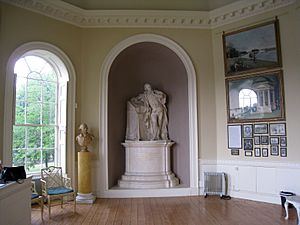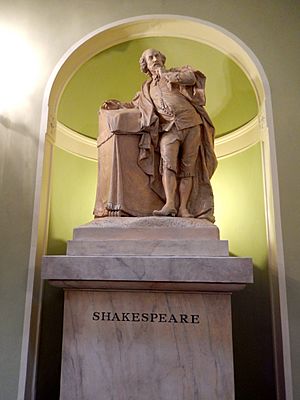Statue of William Shakespeare (Roubiliac) facts for kids

This article is about a famous statue of William Shakespeare. It was made by a sculptor named Louis-François Roubiliac. A well-known actor, David Garrick, asked Roubiliac to create it in 1757. The statue was first placed in Garrick's special building, the Temple to Shakespeare, near his home by the River Thames in Hampton, west of London.
Contents
The Famous Shakespeare Statue
The statue was finished in 1758. It stayed in Garrick's temple until 1779. After Garrick passed away, the statue and his books were given to the British Museum. In 2005, the statue moved to the new British Library. You can see it there today in the main entrance hall, standing on a new stone base.
What the Statue Looks Like
The statue shows Shakespeare standing up. He is leaning his right arm on a tall stand covered with a fancy cloth. His right foot is forward, and his body leans to the right. His right hand holds a feather pen. His left hand is raised to his chin, with his finger along his jaw. This makes him look like he is deep in thought.
Shakespeare in the statue has a beard and some hair loss. He has curly hair near his temples. He is not wearing clothes from his own time, the Tudor period. Instead, he wears 17th-century clothes, like a fancy shirt with lace, a long jacket, short trousers, stockings, and heeled shoes. A large cloak drapes around him.
How the Statue Was Designed
The way Shakespeare's body looks in the statue might be based on David Garrick himself. The head of the statue was inspired by a famous painting called the Chandos portrait. Roubiliac used a copy of this portrait, painted by Joshua Reynolds, to help him.
There is also a portrait of Roubiliac by Adrien Carpentiers, painted in 1762. It shows the sculptor working on a small clay model of the Shakespeare statue. This painting is now in the National Portrait Gallery, London.
Other Versions and Studies
Many smaller models and studies of the statue still exist. Some molds and plaster busts were sold after Roubiliac died in 1762.
- A small clay model, about 42.2 centimeters (16.6 inches) tall, was made in 1757. It shows the whole statue and is now at the Victoria and Albert Museum.
- The Folger Shakespeare Library has another clay model from 1757, about 22 inches (56 centimeters) tall. They also have an 18th-century marble bust of Shakespeare, based on Roubiliac's work.
- The British Museum bought a clay bust by Roubiliac in 1762. It was made in several pieces.
- Another clay bust, from 1742, is at the Garrick Club. It was once thought to be at the Lincoln's Inn Fields Theatre.
- There is also a bust at the Royal Shakespeare Theatre Memorial Gallery in Stratford-upon-Avon. A plaster version is in the State Library of New South Wales.
An art expert named Margaret Whinney said that Roubiliac's bust has "Van-Dyckian elegance." She also noted that he made Shakespeare's head look very noble.
Images for kids
-
Johan Zoffany, David Garrick and his Wife by his Temple to Shakespeare at Hampton, around 1762.
-
Adrien Carpentiers, Portrait of Louis-Francois Roubiliac, 1762.
-
Adrien Carpentiers, Louis-Francois Roubiliac Modelling His Monument to Shakespeare, 1760-1761.
-
Roubiliac's clay bust of Shakespeare at the British Museum.
-
The monument to William Shakespeare in Poets' Corner at Westminster Abbey.







